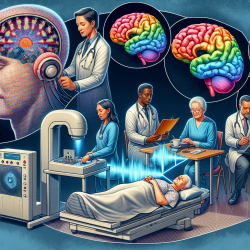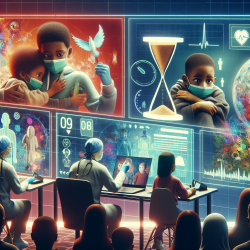Introduction
In the realm of speech-language pathology, ensuring optimal cognitive outcomes for children and adults alike is paramount. Recent research, particularly the study titled "Whole brain atlas-based diffusion kurtosis imaging parameters for the evaluation of multiple cognitive-related brain microstructure injuries after radiotherapy in lung cancer patients with brain metastasis," offers valuable insights that can be leveraged to enhance therapeutic practices. This blog delves into the findings of this study and explores how practitioners can integrate these insights into their practice to improve cognitive outcomes.
Understanding the Study
The study investigated the potential of diffusion kurtosis imaging (DKI) parameters to detect early radiation-induced brain injuries and their association with neurocognitive function (NCF) decline. Conducted on lung cancer patients with brain metastasis who underwent whole brain radiation therapy (WBRT), the research identified specific brain regions susceptible to cognitive decline post-radiotherapy. Notably, the study found significant correlations between changes in DKI parameters and cognitive function, highlighting nine regions particularly vulnerable to radiation-induced impairment.
Key Findings and Implications
- DKI parameters, including mean kurtosis (MK) and axial kurtosis (AK), are sensitive indicators of early microstructural changes in the brain.
- Nine brain regions, such as the right orbital part of the inferior frontal gyrus and left middle temporal gyrus, showed significant correlations with cognitive decline.
- The study suggests these regions as potential targets for dose-avoidance strategies in radiotherapy to preserve cognitive function.
Practical Applications for Practitioners
For speech-language pathologists and related practitioners, these findings underscore the importance of integrating advanced imaging techniques like DKI into clinical practice. Here are some actionable steps:
- Collaborate with Radiologists: Work closely with radiologists to interpret DKI results and identify patients at risk of cognitive decline post-radiotherapy.
- Develop Personalized Intervention Plans: Use DKI data to tailor intervention strategies that focus on preserving cognitive functions in identified vulnerable regions.
- Advocate for Advanced Imaging: Encourage the adoption of DKI in clinical settings to enhance early detection and intervention of cognitive impairments.
Encouraging Further Research
The study opens avenues for further research into the role of DKI in speech-language pathology. Practitioners are encouraged to explore the following areas:
- Longitudinal Studies: Conduct long-term studies to assess the impact of DKI-guided interventions on cognitive outcomes.
- Broader Applications: Investigate the applicability of DKI in other neurological conditions affecting cognitive function.
- Interdisciplinary Research: Collaborate with neuroscientists and radiologists to deepen the understanding of brain microstructure changes and their implications for therapy.
Conclusion
Incorporating the findings from this study into clinical practice can significantly enhance cognitive outcomes for patients undergoing radiotherapy. By leveraging advanced imaging techniques like DKI, practitioners can develop more targeted and effective intervention strategies. As we continue to strive for excellence in speech-language pathology, embracing data-driven approaches and fostering interdisciplinary collaboration will be key to achieving optimal patient outcomes.
To read the original research paper, please follow this link: Whole brain atlas-based diffusion kurtosis imaging parameters for the evaluation of multiple cognitive-related brain microstructure injuries after radiotherapy in lung cancer patients with brain metastasis.










